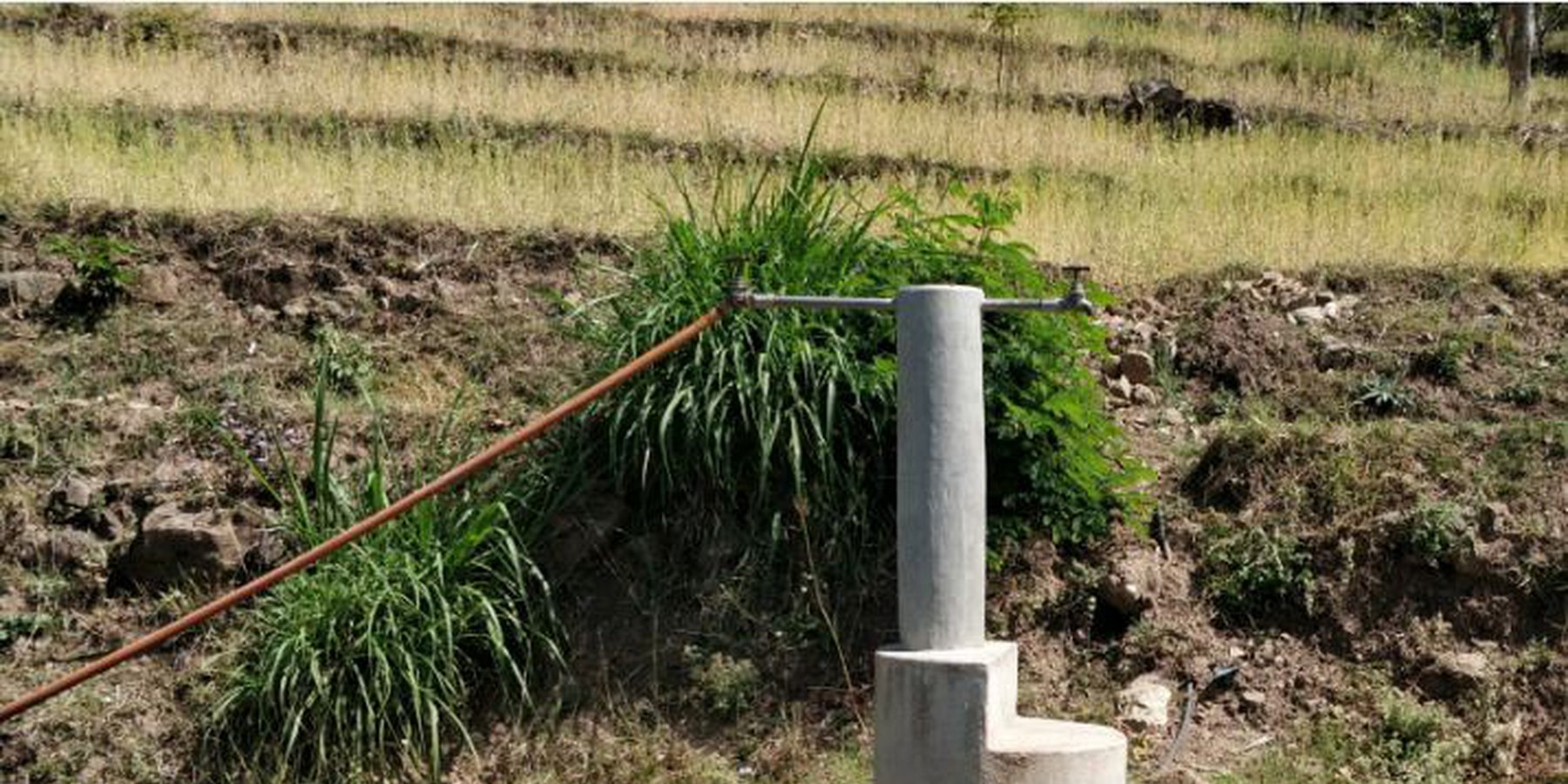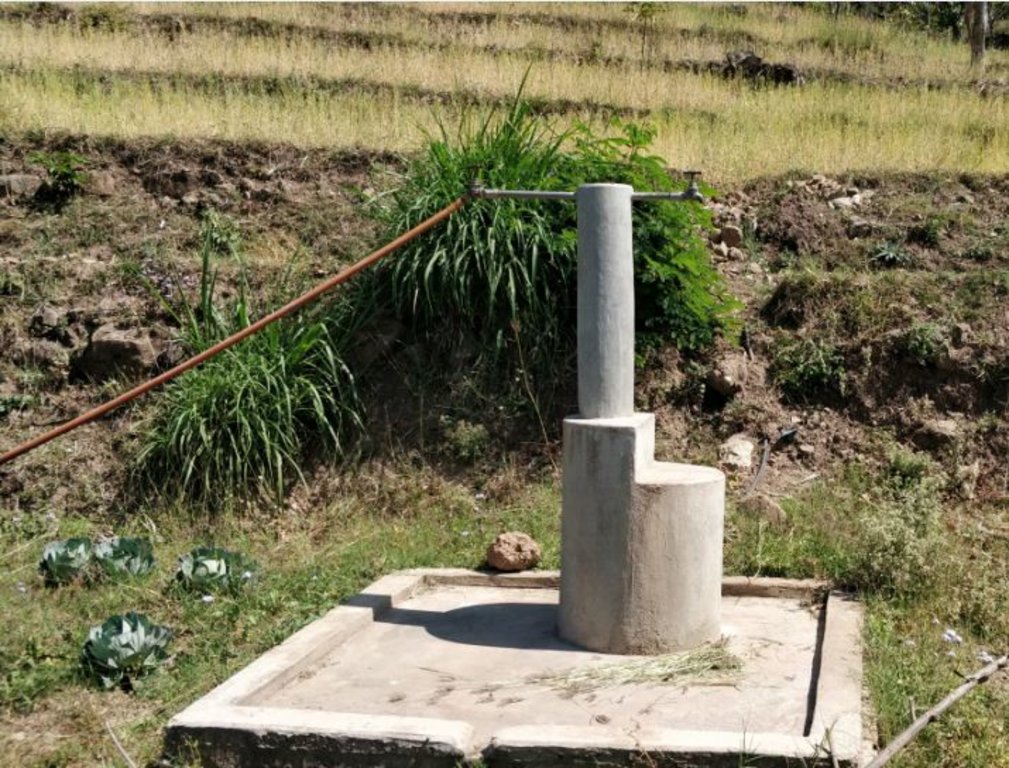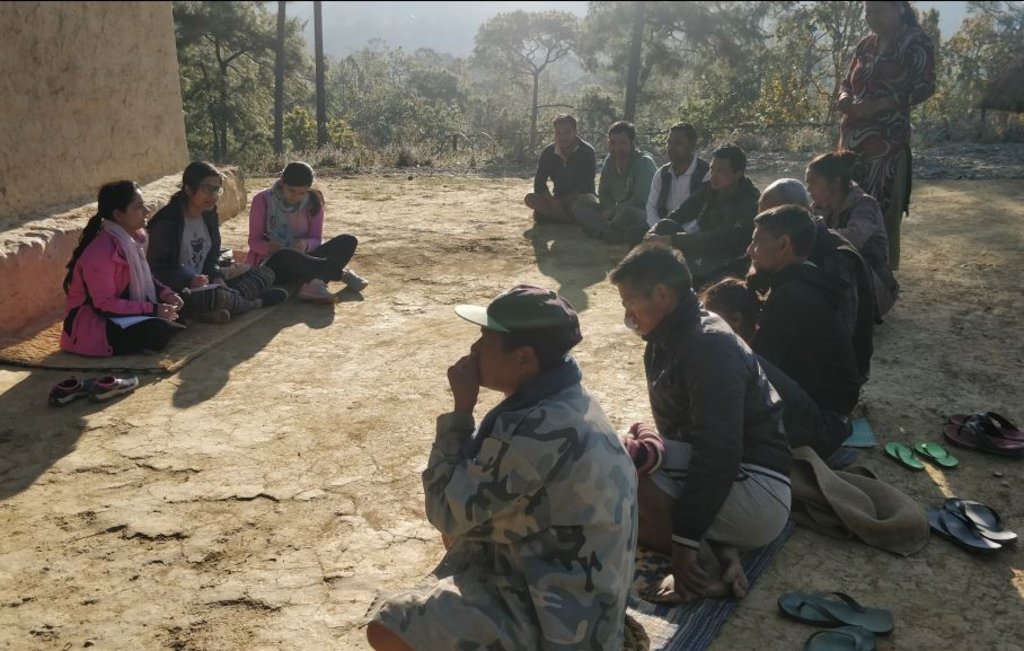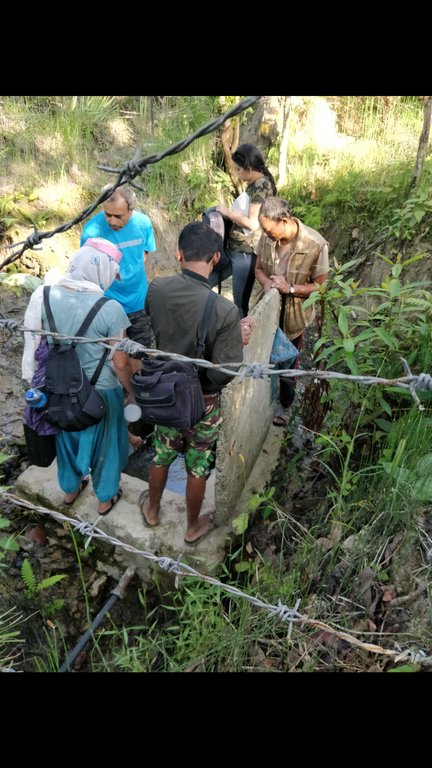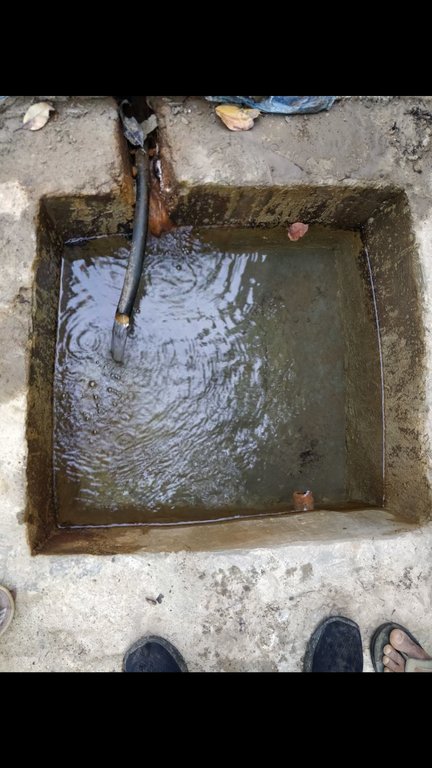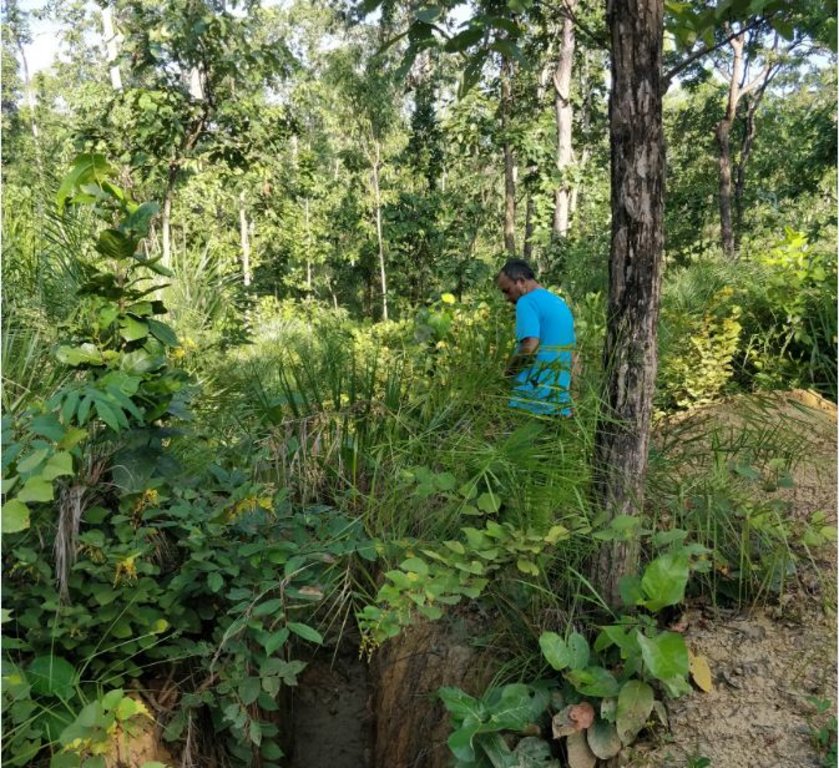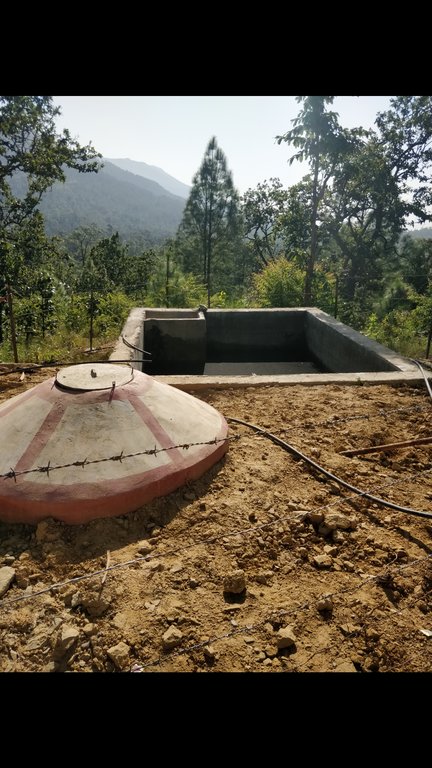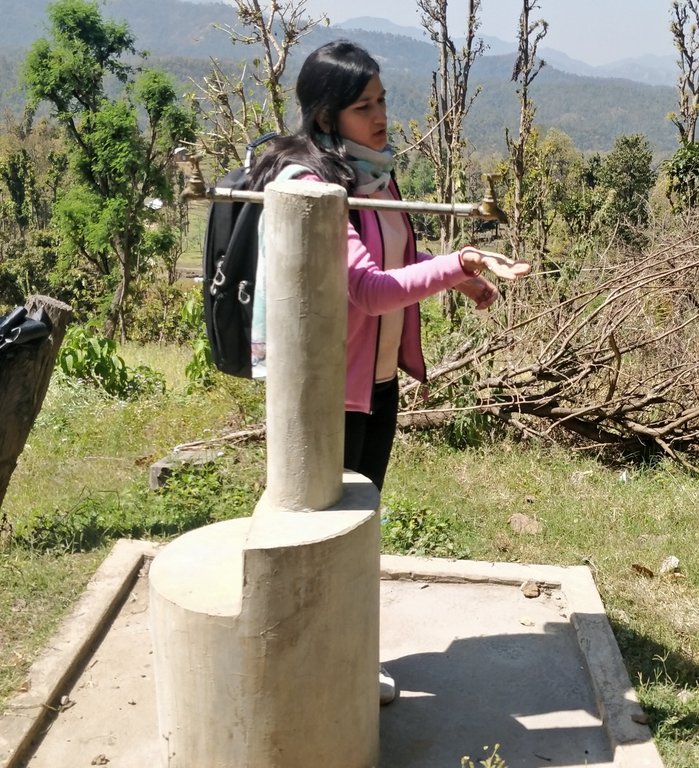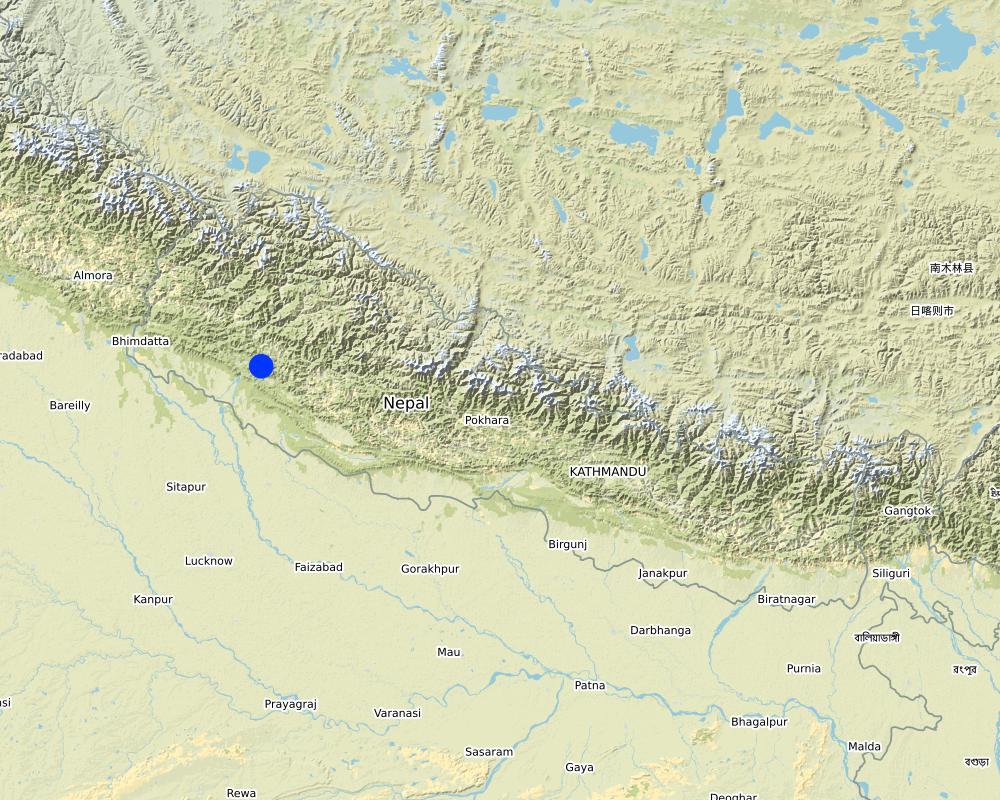Gravity-Fed Multiple Use Water System (MUWS) : Odaltaal [Непал]
- Шинийг нээх:
- Шинэчлэх:
- Эмхэтгэгч: Jhuna Kattel
- Хянан тохиолдуулагч: –
- Хянагч: Renate Fleiner
Odaltaal Ghaito
technologies_5182 - Непал
Бүлгүүдийг үзэх
Бүгдийг дэлгэх Бүгдийг хаах1. Ерөнхий мэдээлэл
1.2 Технологийг үнэлэх, баримтжуулах ажилд хамаарах мэдээлэл өгсөн хүмүүс, байгууллагуудын холбоо барих мэдээлэл
Мэдээлэл өгсөн хүн (с)
Water User:
Sunar Kopila
Непал
Технологи баримтжуулах/үнэлэх ажилд дэмжлэг үзүүлсэн төслийн нэр (шаардлагатай бол)
Prospects and challenges of water use systems as climate adaptive option for sustainable water management in Himalayan RegionТехнологи баримтжуулах/үнэлэх ажилд дэмжлэг үзүүлсэн байгууллага(ууд)-ын нэр (шаардлагатай бол)
Kathmandu University (KU) - Непал1.3 ВОКАТ-аар баримтжуулсан өгөгдлийг ашиглахтай холбоотой нөхцөл
Эмхэтгэгч болон гол мэдээлэгч хүн(хүмүүс) WOCAT аргачлалаар баримтжуулсан мэдээллийг ашиглахтай холбоотой нөхцлийг хүлээн зөвшөөрсөн:
Тийм
1.4 Технологи тогтвортой гэдгийг баталгаажуулах
Энэ технологийг газрын доройтлыг бууруулж, газрын тогтвортой менежментийг хангахад тохиромжтой гэж үзэж болох уу?
Үгүй
Тайлбар:
The technology used serves as a source of providing water for drinking and other multiple uses; such that it acts as a means to conserve and manage water resources rather than degrade them.
2. ГТМ Технологийн тодорхойлолт
2.1 Технологийн товч тодорхойлолт
Технологийн тодорхойлолт:
Water from source in hill top is collected in a small reservoir (to preserve natural source), then passes onto a Reservoir Tank (RVT) / Ferro-Cement Tank / "Ghaito" for drinking water with a capacity of 4000L. When the RVT gets filled, water overflows, is collected in another concrete irrigation pond (10,000L) for irrigation. From the ferro-cement tank (Ghaito) and concrete irrigation pond, two pipelines are fed and water supplied into individual tap-system or MUWS tap towers for multiple purposes.
2.2 Технологийн дэлгэрэнгүй тодорхойлолт
Тодорхойлолт:
The technology is applied in a natural environment, i.e. natural water source. The source of water is a natural source of water that sits atop a small hill which is owned by the government. From the source, water is collected in RVT ( for drinking water) and concrete irrigation pond ( for irrigation). PVC pipes are fed onto the tanks to distribute the water for multiple purposes to 4 MUWS tap towers or tap systems or "Thaado". These MUWS tap towers consist of two faucets each- one for drinking and the other for irrigation and other purposes.The major purposes of this technology are to supply clean water for drinking and other multiple purposes through a cheap, effective and simple system. The natural source of water is locally maintained. Operation and maintenance works are not mandatory, however the locals are responsible for maintaining it should the need arise. The system was financed through a public-private-partnership (PPP) program; out of which some amount was funded by a Non-Governmental Organization (NGO)- Sundar Nepal ( NPR. 2,77,000 ), some amount by the Village Development Committee (VDC)- (NPR. 2,63,000), and the remaining amount was collected by a locals’ group (NPR. 60,000). For establishing the system, labor and construction materials were needed for building the tanks and pipeline systems. For the maintenance, manual labor is necessary. The quality of the water that is supplied to the households is good and the quantity seems sufficient for the 19 households. Sustainable use of water resources through a MUWS system, cheap and effective way to conserve water resources, ensuring availability of clean water even through dry seasons are some of the technology's advantages. Similarly, clean water, more water for irrigation for vegetable farming, simplifying day-to-day life are some of the strengths of the technology. Dislikes could be the limited availability of water during the dry season and that out of 4 systems only 2 are in operation and the other ones are in a non-working condition.
Management system in place for MUWS:
A separate committee is set up for the smooth operation of the system, which consists of 20 members- 10 males and 10 females. The head of the committee is Mrs. Kopila Sunar. The committee conducts a monthly meeting to discuss the problems and need of maintenance. During the initial setup, the connection of pipelines from the tap systems to the reservoir tanks was, however, done with the contribution of the locals. Every month, each family from the 19 households contributes NPR. 100 ( One Hundred Rupees) , which goes to a fund that is set up for the times of need. The labor contribution by the people of the VDC was dependent upon the number and availability of family members in the household. Similarly, the use of the MUWS system and water from it is also dependent upon the availability of family members. Little to no maintenance was done to the system till now from 2075 B.S. ( 1 years) . Equal number of male and female members are in the committee dedicated to the MUWS system.
2.3 Технологийн гэрэл зураг
2.5 Энэ үнэлгээнд хамрагдсан технологийг хэрэгжүүлсэн улс орон/ бүс нутаг/ байршил
Улс:
Непал
Улс/аймаг/сум:
Province-6, Mid-Western Development Region
Байршлын дэлгэрэнгүй тодорхойлолт:
Kunathari VDC-10, Odaltaal
Технологи өргөн дэлгэрсэн эсхийг тодорхойл:
- тодорхой газар хэрэгжсэн/ жижиг талбайд төвлөрсөн
Технологи(иуд) нэвтрүүлсэн талбай тусгай хамгаалалттай газар нутагт байрладаг уу?
Үгүй
Map
×2.6 Хэрэгжсэн хугацаа
Хэрэгжүүлсэн он:
2018
2.7 Технологийн танилцуулга
Технологийг хэрхэн нэвтрүүлснийг тодорхойл:
- Гадны төсөл/хөтөлбөрийн дэмжлэгтэйгээр
Тайлбар (төслийн төрөл г.м.):
Sundar Nepal- a non-governmental organization (NGO) helped with Odaltaal Multiple Use Water Systems
3. ГТМ технологийн ангилал
3.1 Технологийн үндсэн зорилго (ууд)
- үйлдвэрлэлийг сайжруулах
- газрын доройтлыг бууруулах, сэргийлэх, нөхөн сэргээх
- уур амьсгалын өөрчлөлт/ экстрим байдал болон түүний нөлөөлөлд дасан зохицох
- үр ашигтай эдийн засгийн нөлөөг бий болгох
- improve water security and increase efficient use at a household level
3.2 Технологи нэвтрүүлсэн газрын одоогийн газар ашиглалтын хэлбэр(үүд)

Тариалангийн талбай
- Нэг наст үр тариа
- Олон наст (модлог биш) үр тариа
Нэг наст үр тариа - Таримлыг тодорхойлно уу:
- үр тариа - арвай
- үр тариа - эрдэнэ шиш
- үр тариа - цагаан будаа (өндөр газрын)
- үр тариа - улаан буудай (эрт ургацын)
- үр тариа - улаан буудай (өвлийн)
Олон наст (модлог биш) тариалан - Таримлыг тодорхойлно уу:
- арек
- банан/плантан/абака
- чихрийн нишэнгэ
Жилд ургамал ургах улирлын тоо:
- 3
Тодорхойлно уу:
The water used for irrigation is used in fields for 2-3 cycles of crop growing (annual) like rice, maize and barley and into kitchen-farming/tunnel farming (perennial) where vegetables grown are cucumber, tomatoes, chilli, bitterguard, peas, etc.
Сөөлжлөн тариалалт хийгддэг үү?
Үгүй
Таримлыг ээлжлэн тариалдаг уу?
Тийм
Хэрэв тийм бол, тодруулна уу:
Rice, Maize and Wheat are cycled according to the seasons.

Бусад
Тодорхойлно уу:
Drinking Water
Нэмэлт мэдээлэл:
Drinking water used directly from the tap systems. Some boil it but most of them use it straight from the tap systems and consume without filtration.
Тайлбар:
Irrigation and Multiple Uses: The locals use the technology in order to irrigate their cropland so that the plant productivity is increased. As well, the introduction of this technology has opened up doors to new possibilities like construction of tunnels ( green houses) so that the locals can grow seasonal and off-seasonal vegetables in their backyards. Animal husbandry has also been an increasing practice. Human uses like washing, cooking, cleaning, bathing, etc are amply sufficient due to adequacy of water from this technology.
3.3 Технологи хэрэгжүүлснээр газар ашиглалтад өөрчлөлт гарсан уу?
Технологи хэрэгжүүлснээр газар ашиглалтад өөрчлөлт гарсан уу?
- Тийм (Технологи хэрэгжүүлэхээс өмнөх үеийн газар ашиглалтын талаархи асуулгыг бөглөнө үү)

Тариалангийн талбай
- Нэг наст үр тариа
- Олон наст (модлог биш) үр тариа
Нэг наст үр тариа - Таримлыг тодорхойлно уу:
- үр тариа - арвай
- үр тариа - эрдэнэ шиш
Олон наст (модлог биш) тариалан - Таримлыг тодорхойлно уу:
- банан/плантан/абака
Сөөлжлөн тариалалт хийгддэг үү?
Үгүй
Таримлыг ээлжлэн тариалдаг уу?
Үгүй
Тайлбар:
Before the introduction of the technology, the land productivity was minimal. Water for human uses like bathing, cleaning, washing, cooking, etc. were scarce; especially during the dry seasons. No green houses were constructed. They used to rear very few cattle.
3.4 Усан хангамж
бусад (жишээ нь, үерийн дараах):
- Natural source (Mool) of water in foliage atop a hill
Тайлбар:
The supply of water comes from a natural source ( 'mool' in local language) , where a small enclosure is constructed so that the source is preserved and water is amply supplied to the ferrocement RVT for drinking purposes ( 'Ghaito' in local language) and concrete irrigation pond for irrigation purposes.
3.5 Технологи ГТМ-ийн аль бүлэгт хамаарах вэ
- Ус хуримтлуулах
- Усжуулалтын менежмент (усан хангамж, ус зайлуулалт зэрэг.)
- Гүний усны менежмент
- Gravity Fed Multiple Use Water System (MUWS) , New Scheme
3.6 Технологийг бүрдүүлэх ГТМ арга хэмжээ

Барилга байгууламжийн арга хэмжээ
- S5: Далан, усан сан, цөөрөм
- S6: Хашаа, саад, явган хашлага, хашаа
- S7: Ус хуримтлуулах/ усаар хангах/ усалгааны төхөөрөмж
- S11: Бусад
Тайлбар:
The technology is comprised of structural measures, barbed wire fences to surround natural water source, iron lid top, cement enclosure for water source, pipes feeding onto the source, ferro-cement RVT, tap towers, faucets, concrete irrigation pond, etc.
3.7 Технологид харгалзах газрын доройтлын төрөл

усны доройтол
- Hs: Гадаргын усны хэмжээ багасах
- Hp: Гадаргын усны чанар муудах
Тайлбар:
Before setting up the technology, much of the water during dry seasons would evaporate from the natural source ( mool) and there would be scarcity of water during dry seasons. This has been addressed by the technology, where securing the natural source of water prevented evaporation and storing water in enclosed tanks helped supply water during dry seasons.
Similarly, due to no preservation of the source and no storage tanks, the water would be soiled by sediments, wastes and insects' larvae. After setting technology up, the quality of water has vastly improved as well.
3.8 Газрын доройтлоос урьдчилан сэргийлэх, сааруулах ба нөхөн сэргээх
Газрын доройтолтой холбоотойгоор Технологи ямар зорилго тавьсан болохыг тодорхойл:
- газрын доройтлоос урьдчилан сэргийлэх
Тайлбар:
The technology prevents water source degradation, improves perennial water availability, helps tackle with the effects of natural calamities like drought, etc.
4. Техникийн нөхцөл, хэрэгжүүлсэн үйл ажиллагаа, материал ба зардал
4.1 Технологийн техник зураг
Техник тодорхойлолт (техник зургийн тайлбар):
Source: Natural (mool) atop a small hill, secured by wire fences and preserved with concrete and metal lid ( to prevent evaporation).
Water from source collected in Ferro-Cement Tank (RVT) / "Ghaito" in local language, with capacity 4000Ltrs.
Water overflows from RVT into an Irrigation Pond (Open Top, Concrete) with capacity 10,000Ltrs.
PVC Pipes leave the RVT and Pond into 4 MUWS Towers ("Thaado" in local language) to serve 19 households.
One faucet supplies drinking water from RVT and next faucet supplies water for irrigation and other multiple purposes (drip irrigation, tunnel farming, etc.).
4.2 Материал болон зардалд хамаарах ерөнхий мэдээлэл
Үнэ өртөг, оруулсан хувь нэмрийг хэрхэн тооцсоныг тодорхойл:
- Технологийн нэгж тус бүр
Талбайн хэмжээ ба нэгжийг тодорхойл:
5-6 dhurs
Хэрэв өөрийн уламжлалт талбайн хэмжих нэгж ашиглаж байгаа бол нэг га-д шилжүүлэх коэффициент (жишээ нь 1 га = 2.47 акр): 1 га =:
1 ha = 590 dhurs
бусад/үндэсний мөнгөн нэгж (тодорхойл):
NPR
Хэрэв боломжтой бол үндэсний валютын Америк доллартай харьцах харьцааг бичнэ үү (тухайлбал, 1 ам.дол. = 79,9 Бразил реал): 1 ам.дол. =:
110.0
Хөлсний ажилчны нэг өдрийн цалингийн хэмжээг тодорхойлно уу:
N/A ( voluntary labour from each household)
4.3 Бий болгох үйл ажиллагаа
| Үйл ажиллагаа | Хугацаа (улирал) | |
|---|---|---|
| 1. | Enclosement for the groundwater source | Before rainy season |
| 2. | Construction of Ferro-cement tank for Drinking Water | Before rainy season |
| 3. | Construction of Concrete pond for Irrigation | Before rainy season |
| 4. | Securing the perimeter for the tanks | Before rainy season |
| 5. | Laying down the PVC pipework | Before rainy season |
| 6. | Construction of 4 individual MUWS tap towers ( Thaado in Nepalese language) | During rainy season |
| 7. | Final touch-ups, Setting up faucets, Preliminary checking | During rainy season |
Тайлбар:
A total of 3 months ( roughly 90 days ) was required for the construction of the technology to be complete.
4.4 Бий болгоход шаардагдсан зардал, хөрөнгийн өртөг
| Зардлын нэр, төрөл | Хэмжих нэгж | Тоо хэмжээ | Нэгжийн үнэ | Зардал бүрийн нийт өртөг | Нийт дүнгээс газар ашиглагчийн төлсөн % | |
|---|---|---|---|---|---|---|
| Хөдөлмөр эрхлэлт | Voluntary by locals | 100.0 | ||||
| Тоног төхөөрөмж | Irrigation Pond | 1.0 | 275000.0 | 275000.0 | 10.0 | |
| Тоног төхөөрөмж | Ferrocement Tank ( Ghaito) | 1.0 | 225000.0 | 225000.0 | 10.0 | |
| Тоног төхөөрөмж | Securing fences, Perimeter securing for tanks and water source | 1.0 | 50000.0 | 50000.0 | 10.0 | |
| Тоног төхөөрөмж | Setting up MUWS tap towers ( Thaado in local tongue) | 4.0 | 12500.0 | 50000.0 | 10.0 | |
| Тоног төхөөрөмж | PVC Pipes | 100.0 | ||||
| Технологи бий болгох нийт үнэ өртөг | 600000.0 | |||||
| Технологи бий болгох нийт үнэ өртөг, ам.доллар | 5454.55 | |||||
Хэрэв газар ашиглагч нийт зардлын 100% -иас бага хэсгийг төлсөн бол хэн голлох зардлыг гаргасан бэ:
1.Village Developmment Committee:NPR. 2,63,000 2.Sundar Nepal NGO: ~ NPR. 2,77,000 3.Water – Users : NPR. 60,000
4.5 Арчилгаа/ урсгал үйл ажиллагаа
| Үйл ажиллагаа | Хугацаа/ давтамж | |
|---|---|---|
| 1. | Plan on Changing PVC pipework for a Galvanized-Iron (GI) pipe | 1 time after PVC pipes damaged by wear and tear, lime, etc |
| 2. | Plan on Construction of another Drinking Water Tank | When the one tank is not sufficient for providing enough water |
Тайлбар:
Construction has been completed and technology is in use since a year only, so no maintenance works till now. However, construction of another drinking water tank and changing the PVC pipes for GI pipes is imminent in near future.
4.6 Арчилгаа/урсгал ажилд шаардагдсан зардал, хөрөнгийн өртөг (нэг жилд)
| Зардлын нэр, төрөл | Хэмжих нэгж | Тоо хэмжээ | Нэгжийн үнэ | Зардал бүрийн нийт өртөг | Нийт дүнгээс газар ашиглагчийн төлсөн % | |
|---|---|---|---|---|---|---|
| Хөдөлмөр эрхлэлт | Voluntary | 100.0 | ||||
| Тоног төхөөрөмж | Drinking water tank construction | 1 | 1.0 | 75000.0 | 75000.0 | 50.0 |
| Тоног төхөөрөмж | Laying down GI pipesinstead of PVC Pipes | 1 | 1.0 | 50000.0 | 50000.0 | 25.0 |
| Технологийн арчилгаа/урсгал үйл ажиллагаанд шаардагдах нийт үнэ өртөг | 125000.0 | |||||
| Технологи арчилах ба урсгал ажлын нийт үнэ өртөг, ам.доллар | 1136.36 | |||||
Хэрэв газар ашиглагч нийт зардлын 100% -иас бага хэсгийг төлсөн бол хэн голлох зардлыг гаргасан бэ:
The non-governmental organizations and government offices (Village Development Committee) have expressed an interest to help financially in the construction of another drinking water tank and GI pipes laying should the need arise.
Тайлбар:
These are the expected costs should the need of such arise.
The water users' committee, along with NGO's and governmental bodies shall bear the costs in the said maintenance works.
4.7 Зардалд нөлөөлж байгаа хамгийн чухал хүчин зүйл
Өртөг, зардалд нөлөөлөх гол хүчин зүйл:
The construction materials- rods, concrete, cement, bricks and Galvanized Iron (GI) pipes would cost the most
5. Байгаль ба нийгмийн нөхцөл
5.1 Уур амьсгал
Жилийн нийлбэр хур тундас
- < 250 мм
- 251-500 мм
- 501-750 мм
- 751-1,000 мм
- 1,001-1,500 мм
- 1,501-2,000 мм
- 2,001-3,000 мм
- 3,001-4,000 мм
- > 4,000 мм
Хур тунадасны талаархи тодорхойлолт/ тайлбар:
Monsoon/ Rainy Season 2-3 months ( June-August)
Холбогдох цаг уурын станцын нэр:
Meteorological Forecasting Division, Nepal ( www.mfd.gov.np)
Агро-уур амьсгалын бүс
- чийглэг
5.2 Гадаргын хэлбэр
Дундаж налуу:
- хавтгай (0-2 %)
- бага зэрэг налуу (3-5 %)
- дунд зэрэг налуу (6-10 % )
- хэвгий (11-15 %)
- налуу (16-30 %)
- их налуу (31-60 % )
- эгц налуу (>60 %)
Гадаргын хэлбэр:
- тэгш өндөрлөг / тал
- нуруу
- уулын энгэр
- дов толгод
- бэл
- хөндий
Өндрийн бүслүүр:
- 0-100 д.т.д. м.
- 101-500 д.т.д. м.
- 501-1,000 д.т.д м.
- 1,001-1,500 д.т.д м.
- 1,501-2,000 д.т.д м.
- 2,001-2,500 д.т.д. м.
- 2,501-3,000 д.т.д. м.
- 3,001-4,000 д.т.д м.
- > 4,000 д.т.д. м.
Технологи дараах асуудалд хандсан эсэхийг тодорхойл:
- хамааралгүй
5.3 Хөрс
Хөрсний дундаж зузаан:
- маш нимгэн (0-20 см)
- нимгэн (21-50 см)
- дунд зэрэг зузаан (51-80 см)
- зузаан (81-120 cм)
- маш зузаан (>120 cм)
Хөрсний бүтэц (өнгөн хөрс):
- дундаж (элсэнцэр, шавранцар)
- нарийн /хүнд (шаварлаг)
Хөрсний бүтэц (>20 см-ээс доош):
- дундаж (элсэнцэр, шавранцар)
Өнгөн хөрсөнд агуулагдах ялзмаг:
- дунд (1-3 % )
5.4 Усны хүртээмж ба чанар
Гүний усны түвшин:
гадаргаас
Гадаргын усны хүртээмж:
сайн
Усны чанар (цэвэршүүлээгүй):
сайн чанарын ундны ус
Усны чанар гэж:
гадаргын ба газрын доорхи ус
Усны давсжилтын асуудал бий юу?
Үгүй
Энэ газар үерт автдаг уу?
Үгүй
Усны чанар, нөөцийн талаархи тайлбар ба бусад тодорхойлолт:
Before the introduction of MUWS technology, the water used to be a problem during the dry seasons. However, after the technology was applied, the natural ground water source is conserved, people have been monitoring the water levels cautiously and nowadays, the water sustains the locals during the dry seasons as well.
Salinity is not a problem, but the presence of lime in the water is a problem.
5.5 Биологийн олон янз байдал
Зүйлийн олон янз байдал:
- дунд зэрэг
Амьдрах орчны олон янз байдал:
- дунд зэрэг
Биологийн олон янз байдлын талаархи тайлбар ба бусад тодорхойлолт:
Birds are abundant, new fowls are sighted regularly.Lampuchhre ( Long-tailed widowbird),Ravens,Hawks,Peacocks and peafowls,Peasants,Guinea fowls and other fowls; rarely seen before are common after setting up the technology.
Animal sighting is rare. Forests, although consisting of a few varieties of trees, like Saal ( shorea robusta), Sadhana ( Moringa) , Belauti ( Guava), Sallo ( pine tree), Aap ( Mango). very few species are abundant in a given stretch of land.
5.6 Технологи нэвтрүүлсэн газар ашиглагчдын тухай мэдээлэл
Суурьшмал эсвэл нүүдлийн:
- Хагас-нүүдэлийн
Үйлдвэрлэлийн системийн зах зээлийн чиг баримжаа:
- амь зуух арга хэлбэрийн (өөрийгөө хангах)
Бусад эх үүсвэрээс олох орлого:
- Нийт орлогын 10-50 %
Чинээлэг байдлын түвшин:
- ядуу
Хувь хүн эсвэл бүлэг:
- Хувь хүн / өрх
Механикжилтын түвшин:
- гар ажил
Хүйс:
- эмэгтэй
- эрэгтэй
Газар ашиглагчийн нас:
- хүүхэд
- дунд нас
- ахимаг нас
Газар ашиглагчдын бусад шинж чанарыг тодорхойл:
Members of the community: 1:1 ratio of males to females
Age : mostly middle-aged, a few children and few elderly
Caste/ Ethnicity: Thakuri, Dalit and Janajati
Literacy: 1 person completed High – School level (+2), rest are literate ( Class 5)
Total Land Holding: < 10 ropanis of land, Human Settlement since 2040 B.S. ( since last 36+ years) in search of better opportunities and access to better services of water, roads, etc.
Total households: 19
Jobs: Males : bread- earners, construction workers, labour, farming
Females: Housewives, Farming. Most of the males in the village have been to foreign country ( India specially) for manual labour and mostly females are present in the village.
Ethnicity: Few families are of Upper- Caste: Thakuris ( as per Nepalese traditions) and most are Dalits and Janajatis, who were considered low-caste previously. The term "lower-caste" has been abolished now.
5.7 Газар ашиглагчийн технологи нэвтрүүлсэн газрын дундаж талбайн хэмжээ
- < 0.5 га
- 0.5-1 га
- 1-2 га
- 2-5 га
- 5-15 га
- 15-50 га
- 50-100 га
- 100-500 га
- 500-1,000 га
- 1,000-10,000 га
- > 10,000 га
Энэ талбай том, жижиг, дунд алинд хамаарах вэ (орон нутгийн нөхцөлд харгалзуулна уу)?
- бага-хэмжээний
Тайлбар:
19 households occupying less than 10 ropanis of land.
(1 Hectare = 19.66 ropanis)
5.8 Газар эзэмшил, газар ашиглах эрх, ус ашиглах эрх
Газар өмчлөл:
- төрийн
- The source, tanks fall under community forest area- owned by the Government
Газар ашиглах эрх:
- нэгдлийн хэлбэрээр (зохион байгуулалттай)
Ус ашиглах эрх:
- нэгдлийн хэлбэрээр (зохион байгуулалттай)
Газар ашиглах эрх нь уламжлалт эрхзүйн тогтолцоонд суурилсан уу?
Үгүй
Тодорхойлно уу:
Previously, the society had a caste system in which the higher and lower caste discrimination was done and the water tainted by the lower caste ( Dalits, Janajatis) were deemed “unfit” by the upper caste ( Thakuris, Brahmins, Chhetris). However, after the abolishment of the caste system, everyone enjoys equal rights to the access to water.
5.9 Дэд бүтэц, үйлчилгээний хүртээмж
эрүүл мэнд:
- ядуу
- дунд зэргийн
- сайн
боловсрол:
- ядуу
- дунд зэргийн
- сайн
техник зөвлөгөө:
- ядуу
- дунд зэргийн
- сайн
хөдөлмөр эрхлэлт (жишээ нь, ХАА-аас өөр):
- ядуу
- дунд зэргийн
- сайн
зах зээл:
- ядуу
- дунд зэргийн
- сайн
эрчим хүчний хангамж:
- ядуу
- дунд зэргийн
- сайн
зам тээвэр:
- ядуу
- дунд зэргийн
- сайн
усан хангамж ба ариутгал:
- ядуу
- дунд зэргийн
- сайн
санхүүгийн үйлчилгээ:
- ядуу
- дунд зэргийн
- сайн
Тайлбар:
The access to health, education and markets along with other facilities is only accessible after a 15 minute journey to the ‘bazaar’ or market area from the village.
6. Үр нөлөө ба дүгнэлт
6.1 Технологийн талбайд үзүүлсэн нөлөө
Нийгэм-эдийн засгийн үр нөлөө
Үйлдвэрлэл
газар тариалангийн үйлдвэрлэл
үр тарианы чанар
тэжээл үйлдвэрлэл
тэжээлийн чанар
малын бүтээмж
модлогийн бүтээмж
ойн чанар
ойн дагалт баялгийн бүтээмж
бүтээмж буурах эрсдэл
бүтээгдэхүүний олон янз хэлбэр
үйлдвэрлэлийн газар
газрын менежмент
эрчим хүчний үйлдвэрлэл
Усны хүртээмж ба чанар
ундны усны хүрэлцээ
ундны усны чанар
мал услах усны хүрэлцээ
мал услах усны чанар
тариалангийн усалгааны усны хүртээмж
тариалангийн усалгааны усны чанар
тариалангийн усалгааны усны хэрэгцээ
Орлого, зарлага
ХАА-н зардал
тухайн аж ахуйн орлого
орлогын олон янз эх үүсвэр
эдийн засгийн ялгаат байдал
ажлын хэмжээ
Нийгэм-соёлын үр нөлөө
хүнсний аюулгүй байдал/ өөрийн хэрэгцээг хангах
эрүүл мэндийн байдал
газар ашиглалт / усны эрх
соёлын боломжууд
амралт, рекреацийн боломжууд
олон нийтийн институц
үндэсний институц
ГТМ/ газрын доройтлын мэдлэг
Тайлбар/ тодорхой дурьдах:
Knowledge about the technology (MUWS) improved
маргааныг шийдвэрлэх
нийгэм, эдийн засгийн хувьд эмзэг бүлгийнхний нөхцөл байдал
Экологийн үр нөлөө
Усны эргэлт/ илүүдэл
усны хэмжээ
усны чанар
ус хураах / цуглуулах
гадаргын урсац
усны урсац
гүний усны түвшин / уст давхарга
ууршилт
Тайлбар/ тодорхой дурьдах:
evaporation of water decreased after the construction of enclosures / tanks.
Хөрс
хөрсний чийг
хөрсөн бүрхэвч
хөрс алдагдах
хөрс хуримтлагдах
хөрс хагарах/ хагсах
хөрс нягтрах
шимт бодисын эргэлт/ сэргэлт
давсжилт
хөрсний органик нэгдэл/ хөрсөнд агуулагдах карбон
хүчиллэг байдал
Биологийн олон янз байдал: ургамал, амьтан
Ургамалын бүрхэвч
газрын дээрхи / доорхи карбон
ургамлын төрөл, зүйл
түрэмгий, харь зүйл
амьтны төрөл, зүйл
ашигт төрөл зүйл
амьдрах орчны олон янз байдал
хортон шавж/өвчний хяналт
Уур амьсгал болон гамшгийн эрсдлийг бууруулах
үер усны нөлөө
хөрсний гулсалт/ чулуун нуранги
гангийн нөлөө
Тайлбар/ тодорхой дурьдах:
As per water users, effects of drought were imminent in the dry seasons, leading to less water available for drinking and irrigation. However, after the MUWS was installed, the effects of drought could be tackled; mainly due to the availability of water for drinking and drip irrigation, even during the dry and arid winter seasons.
Талбайд илэрсэн үр нөлөөг үнэлнэ үү (хэмжилт):
MUWS focuses mainly on the preservation of water resources through its sustainable use.
Similarly, this technology also addresses the water shortage issues (especially in dry seasons), tackles effects of climate change, ensures water availability in geographically challenged areas, uses minimal modern technologies (relies on gravity for water supply) , is cost-effective ( little to no maintenance costs) and also ensures the social and economic well-being of water users through off-farm and farm incomes ( with the help of drip irrigation).
6.2 Технологийн талбайн гадна үзүүлсэн үр нөлөө
Талбайн гадна илрэх үр нөлөөллийн үнэлгээг тайлбарлана уу (хэмжилтүүд):
Since this technology is adapted in a small area, without any significant construction, there is virtually no off-site impact at the moment.
However, beneficial off-site impacts can be expected in the long run.
6.3 Технологийн уур амьсгалын өөрчлөлт, цаг агаарын гамшигт үзэгдэлд өртөх байдал ба эмзэг байдал (газар ашиглагчийн бодлоор)
Уур амьсгалын аажим өөрчлөлт
Уур амьсгалын аажим өөрчлөлт
| Улирал | Өсөх эсвэл буурах | Технологи түүний нөлөөг хэрхэн бууруулж байна? | |
|---|---|---|---|
| жилийн дундаж температур | Өсөлт | дунд зэрэг | |
| улирлын температур | зун | Өсөлт | дунд зэрэг |
| жилийн дундаж хур тундас | Бууралт | дунд зэрэг | |
| улирлын хур тундас | чийглэг/борооны улирал | Бууралт | дунд зэрэг |
Уур амьсгалаас хамаарах аюул (гамшиг)
Уур амьсгалын гамшиг
| Технологи түүний нөлөөг хэрхэн бууруулж байна? | |
|---|---|
| ган гачиг | дунд зэрэг |
6.4 Өртөг ба ашгийн шинжилгээ
Бий болгох зардалтай харьцуулахад ямар ашиг өгсөн бэ (газар ашиглагчийн бодлоор)?
Богино хугацаанд эргэн төлөгдөх байдал:
эерэг
Арчилгаа/урсгал зардалтай харьцуулахад ямар ашиг өгсөн бэ (газар ашиглагчийн бодлоор)?
Богино хугацаанд эргэн төлөгдөх байдал:
эерэг
Тайлбар:
The system has been in operation since a year only. Thus, long term effects are yet to be visible. Evident from the cost of operation and maintenance with the benefits of the technology, there is a positive impact evident.
6.6 Дасан зохицох
Бий болсон өөрчлөлтөд зохицуулан технологийг өөрчилсөн үү?
Үгүй
6.7 Технологийн давуу тал/боломжууд
| Газар ашиглагчдын тодорхойлсон давуу тал/боломжууд |
|---|
| Substantially less amount of lime present in water than what was previously found. |
| Availability of water even during the dry seasons. |
| Increase in the productivity of perennial vegetables in kitchen garden, construction of tunnels for farming vegetables possible |
| Эмхэтгэгч, бусад мэдээлэл өгсөн хүмүүсийн өнцгөөс тодорхойлсон давуу тал/боломжууд |
|---|
| Water quality vastly improved, no lime and/or saltiness present in water |
| Need of alternative sources of water during dry seasons not present after construction of MUWS system |
| Overall productivity of land improved through effective irrigation of water |
| Self-sufficiency in the aspect of water and crops, as well as alternative sources of income increased leading to improved quality of the lives of the water users. |
6.8 Технологийн дутагдалтай/сул тал/аюул болон тэдгээрийг хэрхэн даван туулах арга зам
| Газар ашиглагч нарын тодорхойлсон сул тал/ дутагдал/ эрсдэл | Тэдгээрийг хэрхэн даван туулах вэ? |
|---|---|
| Water levels not rising in two tap systems of the four | Technician could oversee the problem of elevation and give a viable solution so that 4 out of 4 tap systems could be functional again |
| Pipes’ diameter and quality could be improved | If the government and/or NGO could add to the savings of the group, good quality of GI pipes could be installed instead of the PVC pipes used |
| Эмхэтгэгч, бусад мэдээлэл өгсөн хүмүүсийн өнцгөөс тодорхойлсон сул тал/ дутагдал/ эрсдэл | Тэдгээрийг хэрхэн даван туулах вэ? |
|---|---|
| The tank for irrigation is left open at the top | Closing the top of the tank |
| The pipes used are not sustainable | The use of heavier PVC pipes and/or hybrid GI pipes could result in less chances of system failure due to lime in the water |
7. Ном зүй ба холбоосууд
7.1 Мэдээлэл цуглуулсан арга/эх үүсвэр
- Хээрийн уулзалт, судалгаа
> 10
- Газар ашиглагчтай хийсэн ярилцлага
> 1
Мэдээллийг хэзээ (газар дээр нь) цуглуулсан бэ?
26/05/2019
Тайлбар:
Data collection, compilation done through field visits ( 3 times).
Холбоос ба модулууд
Бүгдийг дэлгэх Бүгдийг хаахХолбоосууд
Холбоос байхгүй байна
Модулууд
Модуль байхгүй байна


